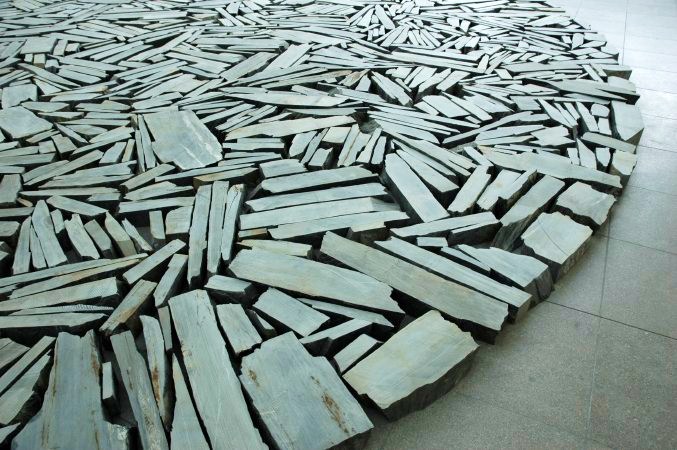The current exhibition at Hamburger Bahnhof – Museum of Contemporary Art in Berlin takes the shape of the circle as the archetypal focus form. The main exhibition hall of the former train station (converted into a museum in 1996) has been turned into a sculptural landscape by the artist Richard Long, whose ‘Berlin Circle’ is part of the Museum’s permanent collection, by the collector Erich Marx.
Richard Long (*1945, Bristol, England) is one of the leading protagonists of ‘Land Art’, along with Michael Heizer, Walter de Maria and Robert Smithson. Coinciding with the first ecological movements in the USA and Europe, Land Art was first created in the 1960s by artists working concurrently but separately from each other, as a critical reaction to the classical genre of sculpture and the commercial art market. The transient and site-specific works, hewn in and from nature, were first unveiled to the public in 1968 in the ‘Earthworks’ exhibition at the Dwan Gallery in New York. A year later, in 1969, Gerry Schum coined the term ‘Land Art’ in his television programme of the same name, and it has been used ever since.
Richard Long uses the movement of his own body, the act of rambling and walking in the countryside as both the gauge and medium for his art. One of his earliest and most well-known works, ‘A Line Made by Walking’, from 1967, consisted in him pacing up and down a field in a straight line so often that a line was drawn in the grass, which the artist then captured on film in the form of a photograph. For over 40 years now, subsequent larger works have been created outdoors all over the world, in England, Canada, Japan and Bolivia: composed of large stone circles or lines made of wood. These temporary works are then documented in photographs. In contrast to such companions of his as Heizer and Smithson, Long’s works do not amount to an intervention in nature, executed in a series of great gestures, for he instead works with material already at hand.
Since he started out as an artist, Long has, however, also shown works in interior spaces. Here too, sculptures are created with archetypal forms of wood or stone: ovals, lines or circles. Long explains his choice of form as follows: ‘I like to use the symmetry of patterns between time, between places and time, between distance and time, between stones and distance, between time and stones. I choose lines and circles because they do the job.’ It is befitting then that the main work in the Hamburger Bahnhof exhibition, ‘Berlin Circle’, is a circle of stone, twelve metres in diameter, laid out on the floor. ‘Berlin Circle’ is an important work in the Sammlung Marx and was first unveiled and installed by the artist for the opening of the Hamburger Bahnhof in 1996. It serves as a thematic focal point in today’s exhibition, emphasising one of the artist’s core forms: the circle. Five other floor pieces are also on display in the historical hall, along with films by and on the artist.
‘My art is in the nature of things’ says Long, referring to the topicality of his works. By being consistently set in places where the nature of things appears in the works, they also throw light on questions in today’s discourse on the relationality, performativeness, transgressions and spatiality of art.
Curator: Prof. Dr. Eugen Blume, Curatorial Assistance: Dr. Katharina Schlüter
https://suitesculturelles.wordpress.com/2011/04/14/richard-long-berlin-circle/
THANKS TO http://en.gravatar.com/lescarabinieres


















































